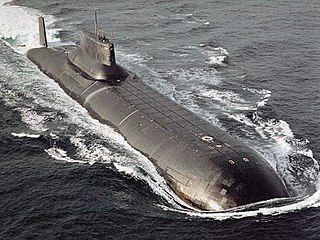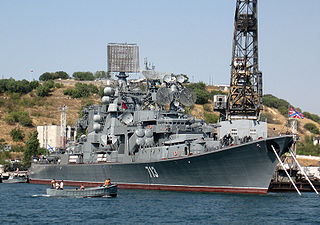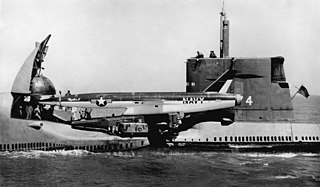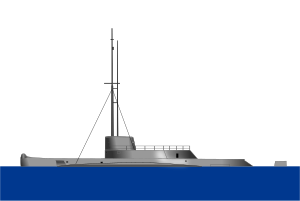
The Resolution class was a class of four nuclear ballistic missile submarines (SSBN) built for the Royal Navy as part of the UK Polaris programme. Each submarine was armed with up to 16 UGM-27 Polaris A-3 nuclear missiles.

The Sturgeon class was a class of nuclear-powered fast attack submarines (SSN) in service with the United States Navy from the 1960s until 2004. They were the "workhorses" of the Navy's attack submarine fleet throughout much of the Cold War. The boats were phased out in the 1990s and early 21st century, as their successors, the Los Angeles, followed by the Seawolf and Virginia-class boats, entered service.

A submarine-launched ballistic missile (SLBM) is a ballistic missile capable of being launched from submarines. Modern variants usually deliver multiple independently targetable reentry vehicles (MIRVs), each of which carries a nuclear warhead and allows a single launched missile to strike several targets. Submarine-launched ballistic missiles operate in a different way from submarine-launched cruise missiles.

K-222 was the first and only Project 661 nuclear-powered cruise-missile submarine built for the Soviet Navy during the Cold War. Although the Soviets saw K-222 as an unsuccessful design, upon completion it was the world's fastest submarine and the first to be built with a titanium hull.

A ballistic missile submarine is a submarine capable of deploying submarine-launched ballistic missiles (SLBMs) with nuclear warheads. These submarines became a major weapon system in the Cold War because of their nuclear deterrence capability. They can fire missiles thousands of kilometers from their targets, and acoustic quieting makes them difficult to detect, thus making them a survivable deterrent in the event of a first strike and a key element of the mutual assured destruction policy of nuclear deterrence.

USS Seawolf (SSN-575) was the third ship of the United States Navy to be named for the seawolf, the second nuclear submarine, and the only US submarine built with a liquid metal cooled (sodium), beryllium-moderated nuclear reactor, the S2G. Her overall design was a variant of Nautilus, but with numerous detail changes, such as a conning tower, stepped sail, and the BQR-4 passive sonar mounted in the top portion of the bow instead of further below. This sonar arrangement resulted in an unusual bow shape above the water for a U.S. submarine. Originally laid down in 1953, her distinctive reactor was later replaced with a standard pressurized water reactor, the replacement process lasting from 12 December 1958 to 30 September 1960.

The George Washington class was a class of nuclear-powered ballistic missile submarines deployed by the United States Navy. George Washington, along with the later Ethan Allen, Lafayette, James Madison, and Benjamin Franklin classes, comprised the "41 for Freedom" group of submarines that represented the Navy's main contribution to the nuclear deterrent force through the late 1980s.

USS Growler (SSG-577) was an early attempt by the U.S. Navy to field a cruise missile submarine that would provide a nuclear deterrent using its second series of cruise missiles. Built to deliver the Regulus I cruise missile, Growler was the second and final submarine of the Grayback class, fourth ship of the United States Navy to be named after the growler. Since Regulus I and Regulus II programs had problems, Growler and Grayback were the only two submarines built in this class as instead, the U.S. Navy veered its nuclear deterrence efforts into submarine launched ballistic missiles (SLBMs)—the Polaris missile program.

The Skipjack class was a class of United States Navy nuclear submarines (SSNs) that entered service in 1959-61. This class was named after its lead boat, USS Skipjack. The new class introduced the teardrop hull and the S5W reactor to U.S. nuclear submarines. The Skipjacks were the fastest U.S. nuclear submarines until the Los Angeles-class submarines, the first of which entered service in 1974.

The Typhoon class, Soviet designation Project 941 Akula, was a class of nuclear-powered ballistic missile submarines designed and built by the Soviet Union for the Soviet Navy. With a submerged displacement of 48,000 tonnes, the Typhoons are the largest submarines ever built, able to accommodate comfortable living facilities for the crew of 160 when submerged for months on end. The source of the NATO reporting name remains unclear, although it is often claimed to be related to the use of the word "typhoon" ("тайфун") by General Secretary Leonid Brezhnev of the Communist Party in a 1974 speech while describing a new type of nuclear ballistic missile submarine, as a reaction to the United States Navy's new Ohio-class submarine.

The Valiant class were a class of nuclear-powered fleet submarines in service with the Royal Navy from the mid-1960s until 1994. They were the first fully British nuclear fleet submarine; the earlier HMS Dreadnought used an American nuclear reactor. There were only two boats in the class, the first, Valiant commissioned in 1966 three years after Dreadnought, and Warspite the following year. Both were built by Vickers at Barrow-in-Furness.

Nuclear marine propulsion is propulsion of a ship or submarine with heat provided by a nuclear reactor. The power plant heats water to produce steam for a turbine used to turn the ship's propeller through a gearbox or through an electric generator and motor. Nuclear propulsion is used primarily within naval warships such as nuclear submarines and supercarriers. A small number of experimental civil nuclear ships have been built.

The Le Redoutable-class submarine was a ballistic missile submarine class of the French Navy. In French, the type is called Sous-marin Nucléaire Lanceur d'Engins (SNLE), literally "Missile-launching nuclear submarine". When commissioned, they constituted the strategic part of the naval component of the French nuclear triad, then called Force de frappe.

The Rubis class is a class of nuclear-powered attack submarines operated by the French Navy. It comprises six boats, the first entering service in 1983 and the last in 1993. Two additional units originally planned were cancelled as a result of post-Cold War budget cuts. All six submarines of the Rubis class are based at Toulon and are part of the Escadrille de sous-marins nucléaires d'attaque. Smaller than contemporary designs of other major world navies, the Rubis class shares many of its system designs with the conventionally-powered Agosta class. In the late 1980s, the Rubis class was proposed to Canada in the context of their plan to acquire nuclear-powered submarines.

HMS Revenge (S27) was the fourth of the Royal Navy's Resolution-class ballistic missile submarines.

The Type 61 Salisbury class was a class of the Royal Navy aircraft direction (AD) frigate, built in the 1950s. The purpose of the aircraft direction ships was to provide radar picket duties at some distance from a carrier task force and offer interception guidance to aircraft operating in their area.

The Kara class, Soviet designation Project 1134B Berkut B, was a class of guided missile cruisers built in the Soviet Union for the Soviet Navy. The NATO lists the class as "cruisers" mainly due to the Metel anti-ship missile system capable of striking not only submarines, but also surface vessels.

The Grayback-class submarine was a class of two guided missile-carrying submarines of the United States Navy. They carried the Regulus I and Regulus II nuclear cruise missiles, deployed 1957–64, that were rapidly phased out by Polaris Submarine Launched Ballistic Missiles (SLBMs). They and USS Halibut were the sole submarines designed specifically to carry Regulus missiles, and the only submarines capable of carrying Regulus II. However, USS Tunny and USS Barbero were modified earlier to carry two Regulus I missiles per boat.
The Chinese submarine with the hull number 201 is a Chinese diesel–electric auxiliary submarine. It is used to test systems and technologies, including test launching ballistic missiles (SLBM). 201 is the sole member of its class, designated Type 032.
JDS Nadashio (SS-577) was a Japanese diesel-electric Yūshio-class submarine weighing 2,250 tons. It was launched on 27 January 1983 and decommissioned by the Maritime Self-Defense Force on 1 June 2001.

















